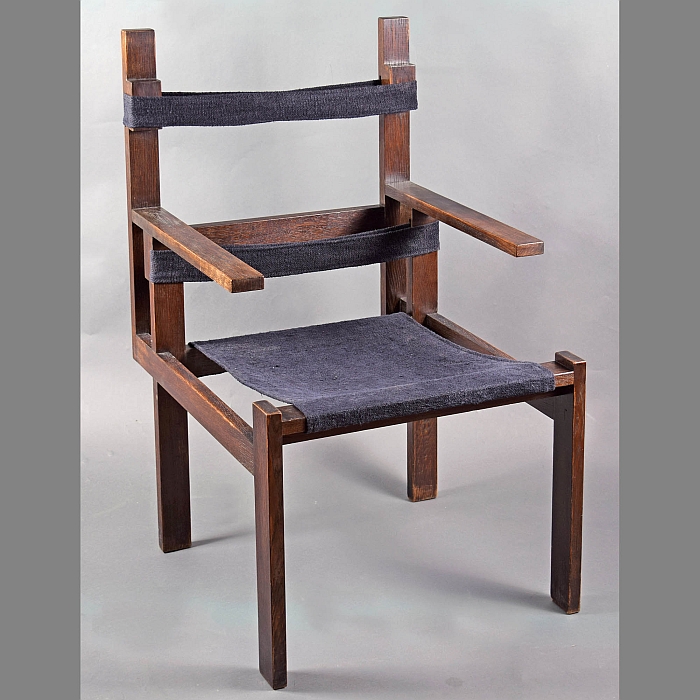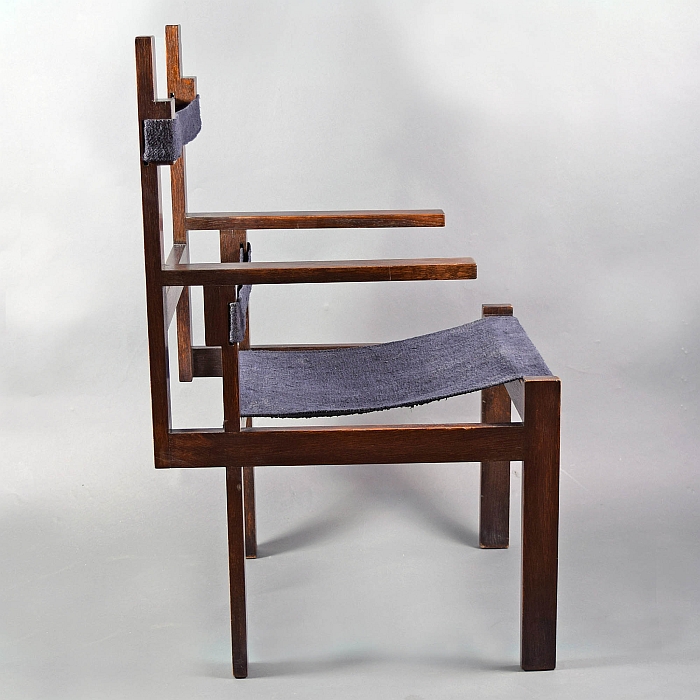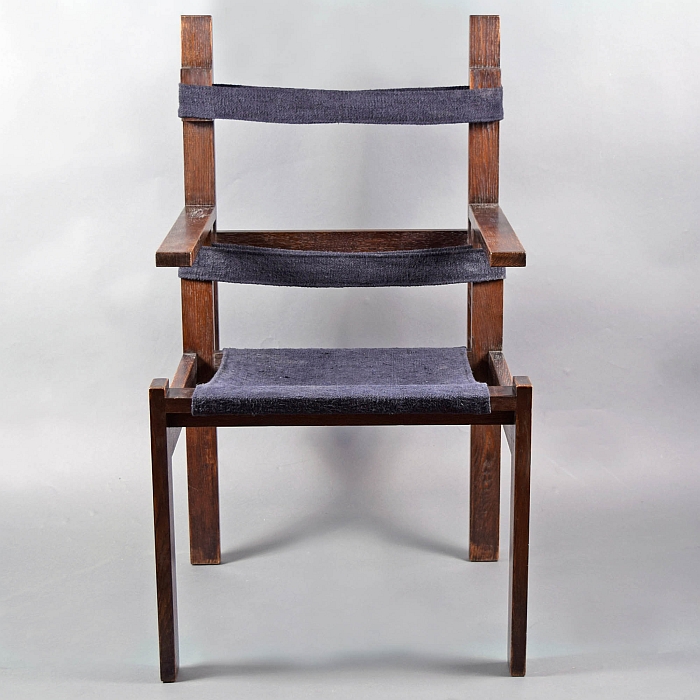smow Blog Interview: Ansgar B. Heickmann, Auktionshaus Heickmann, Chemnitz … Or, How One Sells a Marcel Breuer Chair for Euro 55,000…
“The starting point for the chair was the problem of comfortable seating combined with a simple construction. A problem which led to the defining of the following requirements:
a) Elastic seat and backrest, but no upholstery, which is heavy, expensive and gathers dust
b) Inclination of the seat so as to support the upper leg along its full length without the pressure that arises with a flat seating surface
c) An angled position for the upper body
d) Freedom of the spine because each and very pressure on the spine is both uncomfortable and unhealthy”1
The above description for a chair design may sound contemporary and it was, very contemporary when formulated by Marcel Breuer in 1925.
From this analysis of the requirements of a comfortable chair Marcel Breuer realised his so-called Lattenstuhl, Slatted Armchair, one of his first chair designs and arguably one of the most central in the (hi)story of chair design.
Originally designed in the carpentry workshops at Bauhaus Weimar, Breuer’s Lattenstuhl ignored the conventional structural principles of a chair and instead opted for a skeletal, sculptural wooden frame with pieces of stretched cloth for seat and backrest. According to Breuer the construction principle, and thus the form of the chair, was defined by statics, the pulling direction of the textile and the direction of pressure exerted by the sitter combining to give the object its stability.

The Slatted Armchair, Lattenstuhl, by Marcel Breuer, 1924 (Photo ©/courtesy of HEICKMANN KG, Chemnitz)
Unquestionably influenced by earlier 20th century Dutch designs, including those of Piet Klaarhamer and Gerrit T. Rietveld, the stretched material/reduced skeletal frame concept was one to which Breuer was to return throughout his career, perhaps most notably in his seating for the Aula at Bauhaus Dessau, his early cantilever chairs and his 1925 B3 Wassily Chair, a work which is in effect the Lattenstuhl just in leather and steel tubing. And not only Marcel Breuer would return to such a principle, the 1958 Aluminium Chair collection by Charles and Ray Eames makes use of the same principle and must be considered as being inspired by Breuer’s work.
Conceived as part of an attempt by Bauhaus Weimar to standardise furniture forms to aid production, the Lattenstuhl was produced in small numbers between 1922 and 1925 in the Weimar workshop, albeit without ever achieving any sort of commercial success.2 It’s unconventional form, construction and mix of materials arguably alienating it from a contemporary public who were by no means as avant-garde as the Bauhäusler.
A lack of buyers then need not however mean a lack of buyers now, nor do early 21st century tastes mirror those of the early 20th century and in November 2015 a 1924 Marcel Breuer Lattenstuhl was auctioned for €55,000, the highest price ever attained for such an object in Europe. And that not in London, Milan or Paris……. but in Chemnitz. By Auktionshaus Heickmann.
Established by Ansgar B. Heickmann in 1993 as a, largely, one man operation Auktionshaus Heickmann has grown steadily over the past quarter century and now employs a team of seven art historians who prepare and develop the institution’s programme of auctions; a programme which began as general art and antiques actions but which has evolved to include specialist sales focussing on themes such as, for example, modernist design or folk art from the neighbouring Erzgebirge region.
We met up with Ansgar B. Heickmann to discuss an auctioneers lot in Chemnitz, the contemporary auction business and selling a Marcel Breuer chair for €55,000, but began by asking how, or perhaps better put why, does one become an auctioneer?
Ansgar B. Heickmann: Auctioneering is a passion! I was working in a senior management position for a large textile company, but always knew that I wanted to establish my own business, to be responsible for the consequences of my own decisions. I have had an interest in art and antiques since my youth, was a regular attendee at auctions, and so it was a logical decision to take the leap and establish an auction house.
smow blog: But then why of all places Chemnitz?
Ansgar B. Heickmann: I made the decision in 1992, 1993, so shortly after the fall of the Wall. I had a friend who ran his own auction house in Regensburg and he suggested that I should try in the former East Germany. At that time I was living in Nürnberg, and because the plan was that my family would remain in Nürnberg and I would commute, I looked at the map to see which eastern Germany towns could be possible locations. Leipzig and Dresden were the obvious choices, had however at that time branches of major, west, German auction houses, and so, and in retrospect relatively naively, I decided on Chemnitz. At that time Chemnitz had a population of some 270,000, but within a radius of circa 50, 60 kilometres there was a population of around a million, and so I decided that must be feasible!
smow blog: And does that 50, 60 kilometre radius still form the basis of your customers, or ………?
Ansgar B. Heickmann: For the first auctions we had a purely local public, however that slowly evolved and after five or six years one could start seeing cars from, for example, Mainz, München, Düsseldorf or Hamburg in the car park on auction days. These days it is the case that we have a healthy core of local customers, we can seat 100 people in our auction room and it is regularly full, the majority of our turnover however is online, a fact which I think demonstrates that today it is less important where you base your auction house but that you are known, that people know what you have on offer, that you have a good reputation and for all that the customers trust you. The vast majority of the absentee bidders have never seen the objects for which they are bidding, and often bidding very high sums, and so they need to be able to trust you, your descriptions and your photos.
smow blog: Aside from allowing you to reach a wider audience than would otherwise be the case, in how far has the internet helped, or perhaps better put changed, the auction business over the past decade or so?
Ansgar B. Heickmann: The most important change the internet has brought about is the numerous auction platforms who collate what is currently on offer, as they are achieving an increasingly dominant market position. Just as many hoteliers suffer because of the dominance of the online hotel booking platforms and the associated price erosion, so to are many auction houses suffering because it is naturally easier for customers to search on one platform than research through 30, 40, 50 different auction houses, and that can have an effect on the prices that can be realised. However one must also add that through the internet it has become less important where your customers are, a central part of our business is no longer as it once was about securing customers but about securing interesting, high quality objects for our sales. Which of course brings us back to the importance of your reputation as an auction house and how you treat your sellers and buyers.
smow blog: Which is an excellent introduction to the Breuer Lattenstuhl! How did you mange to secure such an interesting, high quality object? What is, was, the background……
Ansgar B. Heickmann: The Breuer Lattenstuhl came from a source who has sold objects through us in the past, and is someone who I know has an interest in Bauhaus objects and who collects Bauhaus objects, and so I knew it was a serious seller who had experience in the subject. He telephoned, said, somewhat casually, that he had a Bauhaus chair from Marcel Breuer, an early work, would we be interested? We were, and then when he brought the chair here, I was initially impressed by the very good quality, even if at that stage we couldn’t confirm its authenticity. Critics could maintain it is just a few pieces of wood glued together, which in a way it is, but in such a poetic fashion, and in addition it is functional and comfortable……
smow blog: …..moment! You mean you sat in it?
Ansgar B. Heickmann: Yes, I was naturally curious as to how it was. The cloth was no longer the original, the seller had renewed it six or seven years ago, and the seller had also used it, not every day, but did sit in it from time to time; it wasn’t a display object, but a chair which was in use, and so in that respect one took the opportunity, and yes one sits very comfortably in it.
smow blog: As you say critics could argue it is just a few lengths of wood glued together, how does one then prove that it isn’t an object where someone has done just that in their own workshop in, say, the 1980s? How do you establish the authenticity of such an object?
Ansgar B. Heickmann: As a general rule when presented with an object which has the potential to reach a good four or five figure result you should always approach it with a healthy degree of scepticism. Ensuring the authenticity is then essentially a question of careful research. One talks with museums, with specialists, takes measurements, searches historical sources and attempts as far as possible to follow the path of the object backwards. With the Lattenstuhl we could follow its history directly, unequivocally, back to the 1970s, and in the course of our research we didn’t find any evidence of or reference to there ever having been copies produced in earlier periods, largely because Breuer was very attentive and kept good control of such matters. And so when the time came to place it in the catalogue we could be certain that what we were writing was the truth.
smow blog: In terms of that good four or five figure result, according to the catalogue there was a reserve price of €2,800 for the Lattenstuhl, did you set that deliberately low, did you not expect such a high price, or…..
Ansgar B. Heickmann: In the auction business the crucial question is what reserve price do I set for an object? One must always aim for a price which separates, as it were, the wheat from the chaff, a price high enough to make potential bidders think, but without scaring off serious bidders. Anyone who knows the chair, who is familiar with auction of Breuer’s work, knows that such a price is very low and that the final price will be higher, hopes however that the competition have missed the fact it is being sold and that there is a chance for a bargain.
smow blog: And was there immediate interest as soon as you announced the sale?
Ansgar B. Heickmann: When you announce that you have such an object for sale there is very quickly declared interest from a, generally, small group of individuals who, as it were, out themselves as being interested. More important however is what happens in the background, a machine springs into action, dealers, collectors, museums start talking to one another, trying to establish where the object comes from, to see who knows what about it, has it, for example, recently been on the market? Has it been offered to other people? With this chair there was nothing. The chair came from a private owner, was on the market for the first time and the collectors, dealers and museums quickly realised that, realised the opportunity and then had to bid.
smow blog: Which obviously they did, how did you experience the sale?
Ansgar B. Heickmann: The bidding took place exclusively on the telephone. With such an object you generally don’t get many advanced written bids because no one wants to reveal their hand to early, and although the auction room was full, no one in the auction room bid, it was all on the telephone. Until €25,000, €30,000 there was still a lot of bidders in, there was no great shock that we had reached such a price. Above €30,000 the were increasingly fewer bidders, but the golden rule of the auction business is that you only need two bidders, we had them and at the end a German bidder won with a bid of €55,000
smow blog: Can you explain how such an apparently unremarkable chair can achieve such a remarkable price?
Ansgar B. Heickmann: The chair was Breuer’s first design and later his steel tube furniture was simply more relevant and interesting for him, and he never really gave the Lattenstuhl the importance that it deserved. One consequence of this was that Marcel Breuer decided that the Lattenstuhl shouldn’t be commercially produced, as far as we could ascertain Breuer himself produced around 100, so a very small series, and obviously after 90 years and the wars and political regimes we’ve endured over the decades that means there aren’t that many still intact.
smow blog: And we have to ask, when a chair costs €55,000 is it still a chair, is it still a piece of furniture, or does it become something else……?
Ansgar B. Heickmann: Yes, it is still a chair, a much sought after one!
smow blog: Obviously, but can one justify such a price?
Ansgar B. Heickmann: The first thing to say is that the end price was somewhat higher than €55,000, that is the hammer price, on top comes our commission and tax, so that the final invoice sum was a little over €67,000. For that money you could buy yourself a high end BMW or Mercedes, but as we all know as soon as you take delivery of such it loses immensely in value. Or staying with furniture, if you invest in a top quality sofa you can easily spend €15,000 or more, and have something which is new, but continually loses in value. The Breuer Chair has that period of value loss behind it, is a very rare and much sought after work and so the new owner can be fairly certain not only of getting their investment back at a later date but also of making a return on his investment.
smow blog: But did the price surprise you?
Ansgar B. Heickmann: Having done our research we had an idea of what sort of price was possible and in all honesty I would have been disappointed had we not reached a hammer price of over €20,000. But that it went so far over €20,000 was very satisfying as it indicates we had done our job properly, awoken the correct interest and found the correct market for the item, and so I was very happy with the end result.
smow blog: And briefly to end, the chair featured in your 100th auction, after 25 years and a hundred auctions in Chemnitz do you feel at home here? Was that somewhat original naive decision for Chemnitz ultimately a good decision?
Ansgar B. Heickmann: Absolutely, we feel very much at home here, we’ve grown and evolved together with our customers and partners, were acknowledged in the region, people trust us with their objects, and just as importantly come to our sales and follow the auctions with interest which is important for the business, auctions without a live public is a terrible thought because then you lose the unique atmosphere, vibrancy and tension that the public bring to an auction and that make auctions what they are. That time may come but at the moment here in Chemnitz we thankfully still have a public, and one who can enjoy experiences such as the sale of the Breuer Lattenstuhl.
More information on Auktionshaus Heickmann can be found at http://heickmann.eu
The next auction at Auktionshaus Heickmann is a sale of antiques and art and design since 1945 on Saturday March 19th.
1. Marcel Breuer, “Die Möbelabteilung des Staatlichen Bauhauses zu Weimar”, Fachblatt für Holzarbeiter, Berlin, Januar 1925
2. Magdalena Droste und Manfred Ludewig, Marcel Breuer: Design, Taschen, Köln, 1994
Tagged with: Bauhaus, Bauhaus Weimar, chemnitz, Lattenstuhl, Marcel Breuer, Slatted Armchair

